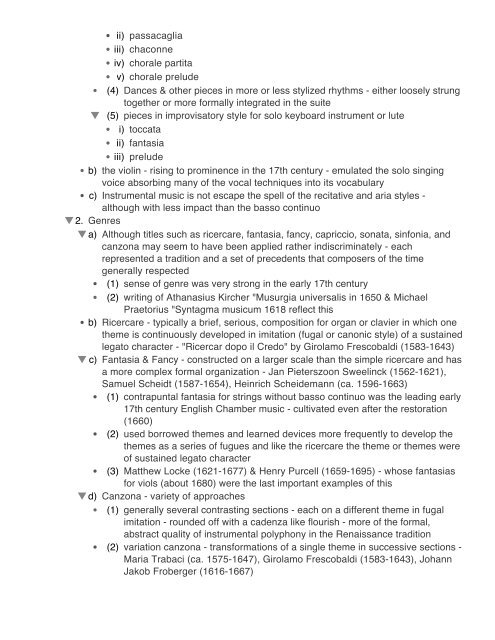An Outline of The History of Western Music Grout ... - The Reel Score
An Outline of The History of Western Music Grout ... - The Reel Score
An Outline of The History of Western Music Grout ... - The Reel Score
Create successful ePaper yourself
Turn your PDF publications into a flip-book with our unique Google optimized e-Paper software.
ii) passacaglia<br />
iii) chaconne<br />
iv) chorale partita<br />
v) chorale prelude<br />
(4) Dances & other pieces in more or less stylized rhythms - either loosely strung<br />
together or more formally integrated in the suite<br />
(5) pieces in improvisatory style for solo keyboard instrument or lute<br />
i) toccata<br />
ii) fantasia<br />
iii) prelude<br />
b) the violin - rising to prominence in the 17th century - emulated the solo singing<br />
voice absorbing many <strong>of</strong> the vocal techniques into its vocabulary<br />
c) Instrumental music is not escape the spell <strong>of</strong> the recitative and aria styles -<br />
although with less impact than the basso continuo<br />
2. Genres<br />
a) Although titles such as ricercare, fantasia, fancy, capriccio, sonata, sinfonia, and<br />
canzona may seem to have been applied rather indiscriminately - each<br />
represented a tradition and a set <strong>of</strong> precedents that composers <strong>of</strong> the time<br />
generally respected<br />
(1) sense <strong>of</strong> genre was very strong in the early 17th century<br />
(2) writing <strong>of</strong> Athanasius Kircher "Musurgia universalis in 1650 & Michael<br />
Praetorius "Syntagma musicum 1618 reflect this<br />
b) Ricercare - typically a brief, serious, composition for organ or clavier in which one<br />
theme is continuously developed in imitation (fugal or canonic style) <strong>of</strong> a sustained<br />
legato character - "Ricercar dopo il Credo" by Girolamo Frescobaldi (1583-1643)<br />
c) Fantasia & Fancy - constructed on a larger scale than the simple ricercare and has<br />
a more complex formal organization - Jan Pieterszoon Sweelinck (1562-1621),<br />
Samuel Scheidt (1587-1654), Heinrich Scheidemann (ca. 1596-1663)<br />
(1) contrapuntal fantasia for strings without basso continuo was the leading early<br />
17th century English Chamber music - cultivated even after the restoration<br />
(1660)<br />
(2) used borrowed themes and learned devices more frequently to develop the<br />
themes as a series <strong>of</strong> fugues and like the ricercare the theme or themes were<br />
<strong>of</strong> sustained legato character<br />
(3) Matthew Locke (1621-1677) & Henry Purcell (1659-1695) - whose fantasias<br />
for viols (about 1680) were the last important examples <strong>of</strong> this<br />
d) Canzona - variety <strong>of</strong> approaches<br />
(1) generally several contrasting sections - each on a different theme in fugal<br />
imitation - rounded <strong>of</strong>f with a cadenza like flourish - more <strong>of</strong> the formal,<br />
abstract quality <strong>of</strong> instrumental polyphony in the Renaissance tradition<br />
(2) variation canzona - transformations <strong>of</strong> a single theme in successive sections -<br />
Maria Trabaci (ca. 1575-1647), Girolamo Frescobaldi (1583-1643), Johann<br />
Jakob Froberger (1616-1667)<br />
(3) ensemble canzona - a patchwork <strong>of</strong> short thematically unrelated sections that<br />
might be repeated literally or in varied form later in the work - Tarquinio<br />
Merula (1594-1665)





